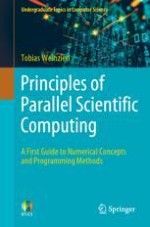2021 | OriginalPaper | Chapter
3. Our Model Problem (Our First Encounter with the Explicit Euler)
Author : Tobias Weinzierl
Published in: Principles of Parallel Scientific Computing
Publisher: Springer International Publishing
Activate our intelligent search to find suitable subject content or patents.
Select sections of text to find matching patents with Artificial Intelligence. powered by
Select sections of text to find additional relevant content using AI-assisted search. powered by
